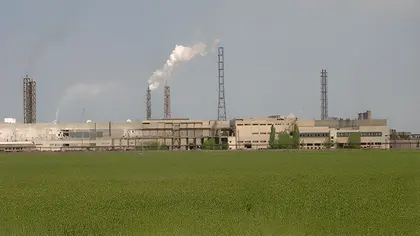Russian army engineers have rigged a giant industrial chemical plant built next to a toxic acid lake the size of a small city with explosives, and if the Kremlin orders the charges set off Ukraine and neighboring states will face a man-made disaster potentially worse than Chornobyl, officials and independent news platforms warned.
Covering a territory of 4.7 square kilometers and sited near the city Armiansk, the sprawling Crimean Titan plant in its heyday was one of the world’s biggest producers of titanium dioxide, a non-toxic industrial chemical widely used in the production of paints, coatings, food supplements, in medicines, and as a whitener.
- Access the latest Ukraine news coverage for today.
- Access the latest Ukraine news coverage for today.
- Ukraine War Casualties
JOIN US ON TELEGRAM
Follow our coverage of the war on the @Kyivpost_official.
Use of titanium dioxide was banned in Europe in 2022. A fine, white dust, the chemical is considered by some experts potentially to be carcinogenic. It is insoluble and deadly for plants and animals using ground water contaminated by the chemical. Some precursors and byproducts of titanium dioxide production are toxic, including sulfuric acid and sulfuric dioxide gas. Both of those compounds are poisonous and if exposure is severe, they are potentially lethal.
Ukrainian military analyst Roman Svitan, in Thursday evening comments to the Apostrof TV news channel, said Russian authorities in Kremlin-occupied Crimea have already fully prepped the north Crimea plant for demolition, and that Russia’s national leadership would be very likely to blow the factory up to create a toxic chemical barrier, if the Ukrainian army got too near, Svitan said.

Moldova Residents Caught in the Middle of Gas Fight
Located on the Isthmus of Perekop, which connects the Crimean Peninsula to mainland Ukraine, Armiansk together with its adjacent rail switching station city Dzhankoi are a natural bottleneck to travel in or out of the peninsula. The Russian military high command needs only an order to trigger the explosives, and it would turn the region of salt flats, retirement communities and truck farms into a poisonous wasteland, Svitan said.
“The plant is already completely mined, including containers with acid, chlorine and reagents. They recently began to rig explosives there, because they saw the Armed Forces of Ukraine (AFU) could cross the Dnipro (River) and attack Armiansk… Blowing Crimean Titan up will have military expediency for the Russians, since chemical emissions can slow down the movement of the AFU.”
Svitan’s warning echoed statements by other Ukrainian officials, and media reports, predicting dire consequences should Russian Federation authorities continue its campaign of destroying major Ukrainian civilian infrastructure, and in its next move demolish the Crimean Titan plant at Armiansk.
The web magazine Focus used computer modeling to predict that the toxic cocktail of chemicals contained in the plant premises would, if released into the atmosphere, produce a poisonous cloud 50 kilometers wide and, travelling about 200 kilometers a day, potentially reach Turkish, Bulgarian or Russian territory (depending on prevailing winds) in two or three days.
Oleksandr Prokudin, head of the Kherson Regional Defense Command, in a June 2 Telegram video said Russian plans to blow up the plant were well advanced and that if the explosives were to be set off “thousands of tons of toxic materials would be released” in an industrial accident “worse than Chornobyl.”
One of the earliest reports of explosives being placed inside the Crimean Titan plant for its intentional destruction surfaced in early May, when a Telegram channel claiming to be linked with partisans operating in the peninsula, said Russian authorities were planning “ecological terrorism.”
Ukrainian officials first warned of Russian troops rigging explosives in the Kakhovka hydroelectric station in April 2022. At the time, some members of the international community viewed Ukrainian official statements as hyperbolic and overly biased against Russia. Kremlin spokespersons this week accused Ukraine of blowing up the Kakhovka dam, a key piece of Ukraine’s power grid, but without offering credible evidence.
The toxic chemical threat to people and environment near Armiansk’s Crimean Titan plant is well documented. In September 2018 Russian authorities evacuated 4,000 children from Armiansk after noxious sulfur dioxide gas blew into the city.
Kremlin-appointed officials in Crimea said summer heat and low water levels in a reservoir the factory uses to hold industrial waste had evaporated sulfuric acid in the reservoir and, probably, created a poisonous sulfur dioxide gas cloud. Ukrainian officials at the time claimed Russian artillery training near the factory had damaged sulfuric acid holding tanks.
The sulfuric acid reservoir next to the factory covers 42 square kilometers (16 square miles), international news reports said at the time.
Since the outset of Russia’s invasion in February 2022, Kyiv officials have accused the Kremlin of pursuing a strategy of destroying the Ukrainian civilian infrastructure and natural environment in order to compel Ukraine’s population to surrender and, longer term, to eliminate the Ukrainian state and Ukrainians as a nation.
Thousands of Russian missiles launched at Ukrainian civilian targets, forced emigration of residents of occupied regions, abduction of thousands of Ukrainian children, destruction of radiation measuring equipment in the Chernobyl exclusion zone, repeated shelling of chemical plants in Ukrainian cities like Sievierodonetsk and Pavlohrad, and emplacement of explosives in the Zaporizhzhia nuclear power station are, Kyiv has long argued, evidence of that long-term Moscow strategy.
The June 6 demolition of the Kakhovka hydroelectric dam was the latest attack in that long-running Kremlin scorched-earth campaign, Ukrainian President Volodymyr Zelensky said in a June 7 speech televised nationally. Western states allied with Ukraine, such as the US and Britain, have refrained from directly blaming Russia for the Kakhovka disaster, saying there is not yet enough intelligence available to prove it.
You can also highlight the text and press Ctrl + Enter










